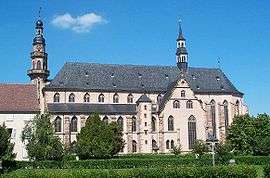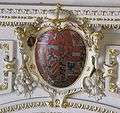Jesuit Church, Molsheim
The former Jesuit Church (Église des Jésuites) is the parish church Sainte-Trinité-et-Saint-Georges (Alsatian: Sànkt-Georg- und Dreifàltigkeitskirich) which is the main Roman Catholic sanctuary of Molsheim, France, and the principal 17th-century church building in the Rhine Valley.[1] The church was built between 1615 and 1617 by the German architect Christoph Wamser, and consecrated on 26 August 1618.[2] Molsheim's Jesuit church is considered one of the foremost examples of Gothic Survival architecture or, as it is called in German, Nachgotik (posterior Gothic). It is listed as a Monument historique since 1939 by the French Ministry of Culture.[3]
| Jesuit Church, Molsheim | |
|---|---|
| Église paroissiale Sainte-Trinité-et-Saint-Georges Église des Jésuites | |
 | |

| |
| Location | Molsheim |
| Country | France |
| Denomination | Roman Catholic |
| History | |
| Founded | 1614 |
| Architecture | |
| Heritage designation | Monument historique |
| Designated | 1939 |
| Architect(s) | Christoph Wamser |
| Style | Gothic Revival Baroque |
| Completed | 1618 |
| Specifications | |
| Length | 70 m (230 ft) |
| Nave width | 25 m (82 ft) |
| Other dimensions | 82.5 m (271 ft) (total length) |
| Spire height | 45 m (148 ft) |
| Administration | |
| Archdiocese | Strasbourg |
Molsheim's Jesuit College was founded in 1580 and dissolved in 1765. It served as Alsace's main university between 1618 and 1704, preceding the Lutheran Strasbourg University in importance. The church's construction was funded by the bishop of Strasbourg, Archduke Leopold V of Austria, who made a donation on his name saint's day, 15 November 1614. Although a chapel inside is dedicated to Ignatius of Loyola, the church was dedicated from the start to the Holy Trinity (Heilige Dreifaltigkeit).[2][4] It became the parish church of Molsheim and was dedicated to Saint-George in 1791, after the demolition of the city's former parish church, the previous Église Saint-Georges, on what is now the town's current market square (Place du marché).[5][6]
The church's dimensions are considerable, especially in relation to the small size of the town: The interior is 70 m (230 ft) long, and the nave is 25 m (82 ft) wide and 20 m (66 ft) high. The choir measuring 19.5 m (64 ft) by 11 m (36 ft), the spire 45 m (148 ft) high. The total length of the church, steeple and sacristy included, is 82 m (269 ft)[7][2][4][A]
Among the many features inside the richly ornate building, the Baroque Saint Ignatius' Chapel (1621–1630) in the north transept and the Rococo Our Lady's Chapel (1748) in the south transept stand out as the most visually striking. Another pride of the church are the 1781 pipe organ by Johann Andreas Silbermann and the monumental Late Gothic cross (1480), 4.5 m (15 ft) high and 2.5 m (8 ft 2 in) wide, from the former Carthusian monastery of the town.[4][8]
 The nave looking towards the choir
The nave looking towards the choir- The nave looking towards the pipe organ
 Saint Ignatius chapel with baptismal font
Saint Ignatius chapel with baptismal font Wooden Renaissance door
Wooden Renaissance door Coat of Arms of Leopold of Austria
Coat of Arms of Leopold of Austria
References
| Wikimedia Commons has media related to Jesuit Church, Molsheim. |
- Ville de Molsheim: Nos monuments (in French)
- Jeffrey Chipps Smith (2002). Sensuous Worship: Jesuits and the Art of the Early Catholic Reformation in Germany. Princeton University Press. p. 121. ISBN 0-691-09072-6.
- Ancienne église des Jésuites, ou église catholique Saint-Georges, French Ministry of Culture database (in French)
- "egliseGB". 19 February 2011. Archived from the original on 19 February 2011. Retrieved 21 July 2020.
- église paroissiale Saint-Georges à Molsheim (the former church) (in French)
- église Sainte-Trinité, Saint-Georges, collège de Jésuites à Molsheim (this church) (in French)
- Oswald, Grégory (2015). L'église des Jésuites. Ville de Molsheim. p. 2.
- The Silbermann organ Archived 5 October 2011 at the Wayback Machine (in French)
Notes
A The numbers of 61.5 m (202 ft) (length), and 21.5 m (71 ft) (width), that are given since 1964 (author Médard Barth), and repeated in 2002 (Smith) and even 2015 (Oswald, page 5), are wrong. According to the floor plan with a scale of 2 cm (0.79 in) per 10 m (33 ft), the dimensions are decidedly higher.